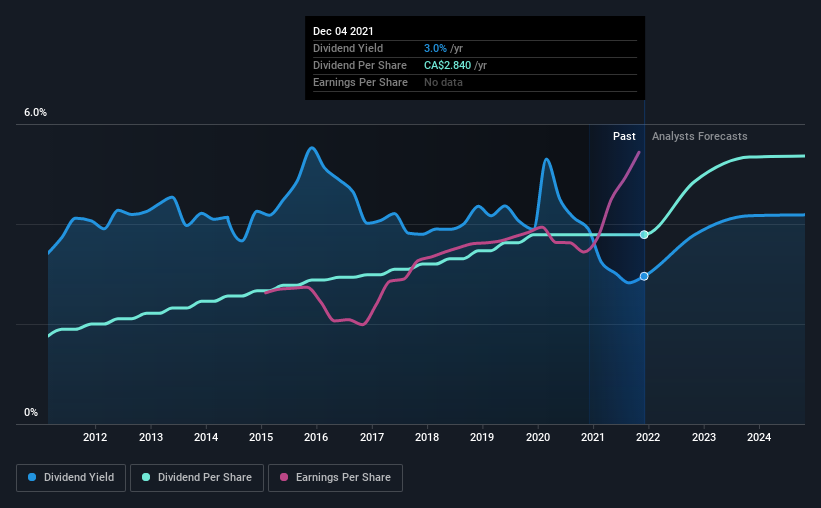National Bank of Canada (TSE:NA) Is Increasing Its Dividend To CA$0.87
National Bank of Canada (TSE:NA) has announced that it will be increasing its dividend on the 1st of February to CA$0.87, which will be 23% higher than last year. Despite this raise, the dividend yield of 3.1% is only a modest boost to shareholder returns.
See our latest analysis for National Bank of Canada
National Bank of Canada's Payment Has Solid Earnings Coverage
While yield is important, another factor to consider about a company's dividend is whether the current payout levels are feasible. National Bank of Canada is quite easily earning enough to cover the dividend, however it is being let down by weak cash flows. In general, we consider cash flow to be more important than earnings, so we would be cautious about relying on the sustainability of this dividend.
Over the next year, EPS is forecast to fall by 0.4%. If the dividend continues along recent trends, we estimate the payout ratio could be 35%, which we consider to be quite comfortable, with most of the company's earnings left over to grow the business in the future.
National Bank of Canada Has A Solid Track Record
The company has a sustained record of paying dividends with very little fluctuation. The first annual payment during the last 10 years was CA$1.32 in 2011, and the most recent fiscal year payment was CA$2.84. This implies that the company grew its distributions at a yearly rate of about 8.0% over that duration. Companies like this can be very valuable over the long term, if the decent rate of growth can be maintained.
The Dividend Looks Likely To Grow
Investors could be attracted to the stock based on the quality of its payment history. We are encouraged to see that National Bank of Canada has grown earnings per share at 22% per year over the past five years. A low payout ratio gives the company a lot of flexibility, and growing earnings also make it very easy for it to grow the dividend.
Our Thoughts On National Bank of Canada's Dividend
In summary, while it's always good to see the dividend being raised, we don't think National Bank of Canada's payments are rock solid. With cash flows lacking, it is difficult to see how the company can sustain a dividend payment. Overall, we don't think this company has the makings of a good income stock.
It's important to note that companies having a consistent dividend policy will generate greater investor confidence than those having an erratic one. However, there are other things to consider for investors when analysing stock performance. Earnings growth generally bodes well for the future value of company dividend payments. See if the 11 National Bank of Canada analysts we track are forecasting continued growth with our free report on analyst estimates for the company. Looking for more high-yielding dividend ideas? Try our curated list of strong dividend payers.
Have feedback on this article? Concerned about the content? Get in touch with us directly. Alternatively, email editorial-team (at) simplywallst.com.
This article by Simply Wall St is general in nature. We provide commentary based on historical data and analyst forecasts only using an unbiased methodology and our articles are not intended to be financial advice. It does not constitute a recommendation to buy or sell any stock, and does not take account of your objectives, or your financial situation. We aim to bring you long-term focused analysis driven by fundamental data. Note that our analysis may not factor in the latest price-sensitive company announcements or qualitative material. Simply Wall St has no position in any stocks mentioned.

 Yahoo Finance
Yahoo Finance 
